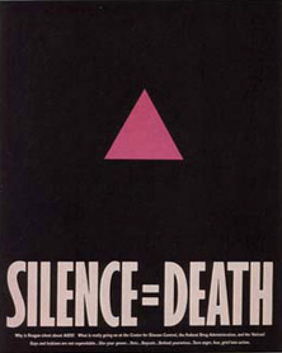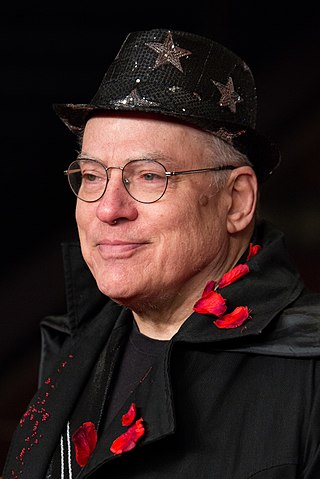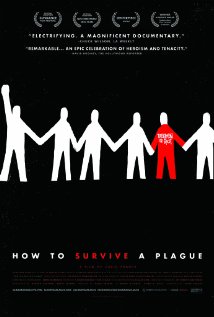Related Research Articles

AIDS Coalition to Unleash Power is an international, grassroots political group working to end the AIDS pandemic. The group works to improve the lives of people with AIDS through direct action, medical research, treatment and advocacy, and working to change legislation and public policies.

David Michael Wojnarowicz was an American painter, photographer, writer, filmmaker, performance artist, songwriter/recording artist, and AIDS activist prominent in the East Village art scene. He incorporated personal narratives influenced by his struggle with AIDS as well as his political activism in his art until his death from the disease in 1992.

General Idea was a collective of three Canadian artists, Felix Partz, Jorge Zontal and AA Bronson, who were active from 1967 to 1994. As pioneers of early conceptual and media-based art, their collaboration became a model for artist-initiated activities and continues to be a prominent influence on subsequent generations of artists.

Emerging from ACT UP in 1988, Gran Fury was an AIDS activist artist collective from New York City consisting of 11 members including: Richard Elovich, Avram Finkelstein, Amy Heard, Tom Kalin, John Lindell, Loring McAlpin, Marlene McCarty, Donald Moffett, Michael Nesline, Mark Simpson and Robert Vazquez-Pacheco.

Holger Bernhard Bruno Mischwitzky, known professionally as Rosa von Praunheim, is a German film director, author, painter and one of the most famous gay rights activists in the German-speaking world. In over 50 years, von Praunheim has made more than 150 films. His works influenced the development of LGBTQ+ rights movements worldwide.

Richard Fung is a video artist, writer, public intellectual and theorist who currently lives and works in Toronto, Ontario. He was born in Port of Spain, Trinidad and is openly gay.
Gregg Gonsalves is a global health activist, an epidemiologist, an associate professor at Yale School of Public Health and an associate professor (adjunct) at Yale Law School. As well as being co-director of Yale Law School's Global Health Justice Partnership, Gonsalves is the public health correspondent of the progressive magazine The Nation.
John Douglas Crimp was an American art historian, critic, curator, and AIDS activist. He was known for his scholarly contributions to the fields of postmodern theories and art, institutional critique, dance, film, queer theory, and feminist theory. His writings are marked by a conviction to merge the often disjunctive worlds of politics, art, and academia. From 1977 to 1990, he was the managing editor of the journal October. Before his death, Crimp was Fanny Knapp Allen Professor of Art History and professor of Visual and Cultural Studies at the University of Rochester.
DIVA TV was a gay and lesbian video activist collective founded in New York City in 1989. The name was an acronym for "Damned Interfering Video Activist Television". Founding members include: Bob Beck, Gregg Bordowitz, Jean Carlomusto, Rob Kurilla, Ray Navarro, Costa Pappas, George Plagianos, Catherine Saalfield, and Ellen Spiro.
Mark Harrington is an HIV/AIDS researcher, a staunch activist for HIV/AIDS and tuberculosis awareness, and the co-founder and policy director of the Treatment Action Group (TAG). After graduating from Harvard University in 1983, Harrington spent time exploring and did not commit to one specific career. When the AIDS epidemic became personal for Harrington, and close friends were being infected with HIV, he decided to take action and joined the group, AIDS Coalition to Unleash Power or ACT UP. As part of the Treatment and Data Committee of ACT UP, Harrington fostered relationships with government officials associated with AIDS research. Eventually differences in opinions on how to best advocate for HIV/AIDS research led to Harrington and other members of ACT UP leaving to start their own group, TAG. With TAG, Harrington was able to create influential and meaningful policy regarding HIV/AIDS research and he worked closely with the NIH, WHO, and other government organizations. Over the years Harrington has distinguished himself as an adept scientist and reputable researcher in his own right. Currently he is published in multiple scientific journals and continues to be an advocate for those with HIV and TB around the world.

How to Survive a Plague is a 2012 American documentary film about the early years of the AIDS epidemic, and the efforts of activist groups ACT UP and TAG. It was directed by David France, a journalist who covered AIDS from its beginnings. France's first film, it was dedicated to his partner Doug Gould who died of AIDS-related pneumonia in 1992. The documentary was produced using more than 700 hours of archived footage which included news coverage, interviews as well as film of demonstrations, meetings and conferences taken by ACT UP members themselves. France says they knew what they were doing was historic, and that many of them would die. The film opened in selected theatres across the United States on September 21, 2012, also includes footage of a demonstration during mass at St. Patrick's Cathedral in 1989.

Peter Staley is an American political activist, known primarily for his work in HIV/AIDS activism. As an early and influential member of ACT UP, New York, he founded both the Treatment Action Group (TAG) and the educational website AIDSmeds.com. Staley is a primary figure in the Oscar-nominated documentary How to Survive a Plague.
Pauline Boudry / Renate Lorenz are a Berlin-based artist duo who have worked together since 2006. They produce film installations that revisit recent and past material, with a particular focus on a critical history of the photographic and moving image itself.

United in Anger: A History of ACT UP is a 2012 documentary film directed by Jim Hubbard about the beginning and progress of the AIDS activist movement from the perspective of the people fighting the epidemic. Archival footage with oral histories of members of ACT UP depicts the history of civil disobedience against corporate greed, social indifference, and government negligence in the face of AIDS. Producers Jim Hubbard and Sarah Schulman created a documentary film that captures the efforts of ACT UP to remove the stigma associated with AIDS, fast track experimental drug research and testing, and provide a context for the devastating effects of the epidemic. Film includes several actions by ACT UP: Seize Control of the FDA, Stop the Church, and Day of Desperation.

The AIDS pandemic began in the early 1980s and brought with it a surge of emotions from the public: they were afraid, angry, fearful and defiant. The arrival of AIDS also brought with it a condemnation of the LGBT community. These emotions, along with the view on the LGBT community, paved the way for a new generation of artists. Artists involved in AIDS activist organizations had the ideology that while art could never save lives as science could, it may be able to deliver a message. Art of the AIDS crisis typically sought to make a sociopolitical statement, stress the medical impact of the disease, or express feelings of longing and loss. The ideologies were present in conceptions of art in the 1980s and are still pertinent to reception of art today as well. Elizabeth Taylor, for example, spoke at a benefit for AIDS involving artwork, emphasizing its importance to activism in that "art lives on forever". This comment articulates the ability of artwork from this time to teach and impact contemporary audiences, post-crisis. This page examines the efforts of artists, art collectives, and art movements to make sense of such an urgent pandemic in American society.
Jean Carlomusto is a New York filmmaker, AIDS activist, and interactive media artist. She produced and directed HBO's Emmy nominated documentary, Larry Kramer in Love & Anger, which was featured at the Sundance Film Festival. Her works have been exhibited internationally in festivals, museums and on television. She was an early pioneer in documenting the AIDS crisis. As the founder of the Multimedia Unit at Gay Men's Health Crisis, she created the television series Living with AIDS. She was a founding member of DIVA TV and a member of the Testing The Limits Video Collective.
Queer art, also known as LGBT+ art or queer aesthetics, broadly refers to modern and contemporary visual art practices that draw on lesbian, gay, bisexual, transgender, and various non-heterosexual, non-cisgender imagery and issues. While by definition there can be no singular "queer art", contemporary artists who identify their practices as queer often call upon "utopian and dystopian alternatives to the ordinary, adopt outlaw stances, embrace criminality and opacity, and forge unprecedented kinships and relationships." Queer art is also occasionally very much about sex and the embracing of unauthorised desires.
Richard Elovich is a social psychologist, writer, performance artist, and AIDS activist focusing on harm reduction and low-threshold approaches to drug treatment.
Daniel Sotomayor was the first openly gay political cartoonist in the United States for various newspapers throughout the country, such as Chicago's Windy City Times, and the cofounder of the AIDS Coalition to Unleash Power organization’s branch in Chicago (ACT-UP/Chicago).
References
- ↑ "Gregg Bordowitz's online Curriculum vitae" (PDF). Greggbordowitz.com. Retrieved 2013-09-09.
- ↑ "A Report on the Archiving of Film and Video Work by Makers with AIDS". Actupny.org. 1986-06-30. Retrieved 2013-09-09.
- ↑ "Robert Atkins.Net". Robert Atkins.Net. Retrieved 2013-09-09.
- ↑ Carter, Rebecca A. (2002-07-07). "Faculty Profile: Gregg Bordowitz". Fnewsmagazine.com. Retrieved 2013-09-09.
- ↑ "Motion Pictures". Greggbordowitz.com. Retrieved 2013-09-09.
- ↑ "Gregg Bordowitz". Artforum.com. Retrieved 2013-09-09.
- ↑ "Projects". Greggbordowitz.com. 2011-03-18. Retrieved 2013-09-09.